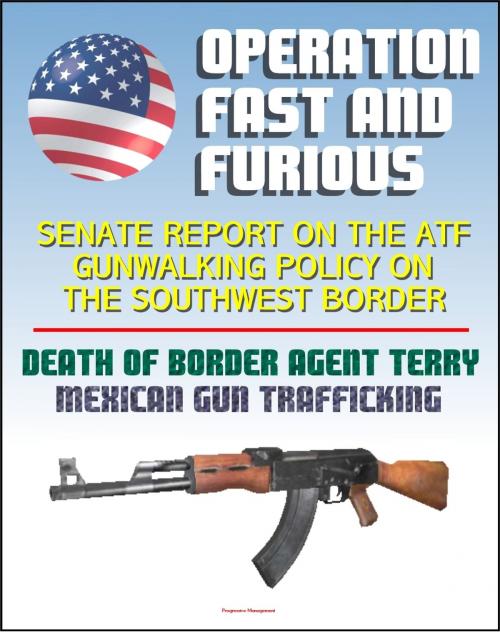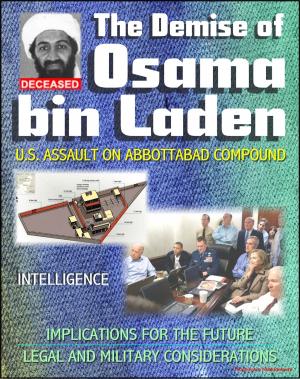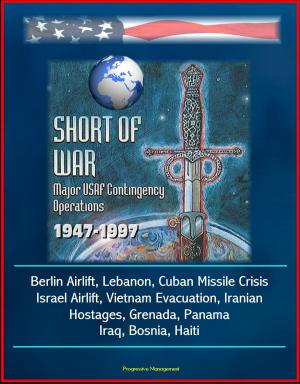Operation Fast and Furious: Senate Report on the ATF Gunwalking Policy on the Southwest Border, Mexican Gun Trafficking, Death of U.S. Border Patrol Agent Brian Terry, Mexico Drug Violence
Nonfiction, Social & Cultural Studies, Political Science, Government, Public Affairs & Administration, Politics, Law Enforcement| Author: | Progressive Management | ISBN: | 9781458148124 |
| Publisher: | Progressive Management | Publication: | June 17, 2011 |
| Imprint: | Smashwords Edition | Language: | English |
| Author: | Progressive Management |
| ISBN: | 9781458148124 |
| Publisher: | Progressive Management |
| Publication: | June 17, 2011 |
| Imprint: | Smashwords Edition |
| Language: | English |
This is a reproduction of a June 2011 Congressional report on the Department of Justice's Operation Fast and Furious, using a strategy called gunwalking which allowed suspects to "walk away" with illegally purchased guns. The report claims that the program facilitated deaths and violence, including the murder of U.S. Border Patrol Agent Brian Terry - called a preventable tragedy.
The Executive Summary states: In the fall of 2009, the Department of Justice (DOJ) developed a risky new strategy to combat gun trafficking along the Southwest Border. The new strategy directed federal law enforcement to shift its focus away from seizing firearms from criminals as soon as possible — and to focus instead on identifying members of trafficking networks. The Bureau of Alcohol, Tobacco, Firearms and Explosives (ATF) implemented that strategy using a reckless investigative technique that street agents call “gunwalking.” ATF’s Phoenix Field Division began allowing suspects to walk away with illegally purchased guns. The purpose was to wait and watch, in the hope that law enforcement could identify other members of a trafficking network and build a large, complex conspiracy case... Operation Fast and Furious was a response to increasing violence fostered by the DTOs in Mexico and their increasing need to purchase ever-growing numbers of more powerful weapons in the U.S. An integral component of Fast and Furious was to work with gun shop merchants, or “Federal Firearms Licensees” (FFLs) to track known straw purchasers through the unique serial number of each firearm sold. ATF agents entered the serial numbers of the weapons purchased into the agency’s Suspect Gun Database. These weapons bought by the straw purchasers included AK-47 variants... This hapless plan allowed the guns in question to disappear out of the agency’s view. As a result, this chain of events inevitably placed the guns in the hands of violent criminals. ATF would only see these guns again after they turned up at a crime scene. Tragically, many of these recoveries involved loss of life. While leadership at ATF and DOJ no doubt regard these deaths as tragic, the deaths were a clearly foreseeable result of the strategy. Both line agents and gun dealers who cooperated with the ATF repeatedly expressed concerns about that risk, but ATF supervisors did not heed those warnings. Instead, they told agents to follow orders because this was sanctioned from above. They told gun dealers not to worry because they would make sure the guns didn’t fall into the wrong hands...
Unfortunately, ATF never achieved the laudable goal of dismantling a drug cartel. In fact, ATF never even got close. After months and months of investigative work, Fast and Furious resulted only in indictments of 20 straw purchasers. Those indictments came only after the death of U.S. Border Patrol Agent Brian Terry. The indictments, filed January 19, 2011, focus mainly on what is known as “lying and buying.” Lying and buying involves a straw purchaser falsely filling out ATF Form 4473, which is to be completed truthfully in order to legally acquire a firearm. Even worse, ATF knew most of the indicted straw purchasers to be straw purchasers before Fast and Furious even began. In response to criticism, ATF and DOJ leadership denied allegations that gunwalking occurred in Fast and Furious by adopting an overly narrow definition of the term. They argue that gunwalking is limited to cases in which ATF itself supplied the guns directly. As field agents understood the term, however, gunwalking includes situations in which ATF had contemporaneous knowledge of illegal gun purchases and purposely decided not to attempt any interdiction. The agents also described situations in which ATF facilitated or approved transactions to known straw buyers.
This is a privately authored news service and educational publication of Progressive Management.
This is a reproduction of a June 2011 Congressional report on the Department of Justice's Operation Fast and Furious, using a strategy called gunwalking which allowed suspects to "walk away" with illegally purchased guns. The report claims that the program facilitated deaths and violence, including the murder of U.S. Border Patrol Agent Brian Terry - called a preventable tragedy.
The Executive Summary states: In the fall of 2009, the Department of Justice (DOJ) developed a risky new strategy to combat gun trafficking along the Southwest Border. The new strategy directed federal law enforcement to shift its focus away from seizing firearms from criminals as soon as possible — and to focus instead on identifying members of trafficking networks. The Bureau of Alcohol, Tobacco, Firearms and Explosives (ATF) implemented that strategy using a reckless investigative technique that street agents call “gunwalking.” ATF’s Phoenix Field Division began allowing suspects to walk away with illegally purchased guns. The purpose was to wait and watch, in the hope that law enforcement could identify other members of a trafficking network and build a large, complex conspiracy case... Operation Fast and Furious was a response to increasing violence fostered by the DTOs in Mexico and their increasing need to purchase ever-growing numbers of more powerful weapons in the U.S. An integral component of Fast and Furious was to work with gun shop merchants, or “Federal Firearms Licensees” (FFLs) to track known straw purchasers through the unique serial number of each firearm sold. ATF agents entered the serial numbers of the weapons purchased into the agency’s Suspect Gun Database. These weapons bought by the straw purchasers included AK-47 variants... This hapless plan allowed the guns in question to disappear out of the agency’s view. As a result, this chain of events inevitably placed the guns in the hands of violent criminals. ATF would only see these guns again after they turned up at a crime scene. Tragically, many of these recoveries involved loss of life. While leadership at ATF and DOJ no doubt regard these deaths as tragic, the deaths were a clearly foreseeable result of the strategy. Both line agents and gun dealers who cooperated with the ATF repeatedly expressed concerns about that risk, but ATF supervisors did not heed those warnings. Instead, they told agents to follow orders because this was sanctioned from above. They told gun dealers not to worry because they would make sure the guns didn’t fall into the wrong hands...
Unfortunately, ATF never achieved the laudable goal of dismantling a drug cartel. In fact, ATF never even got close. After months and months of investigative work, Fast and Furious resulted only in indictments of 20 straw purchasers. Those indictments came only after the death of U.S. Border Patrol Agent Brian Terry. The indictments, filed January 19, 2011, focus mainly on what is known as “lying and buying.” Lying and buying involves a straw purchaser falsely filling out ATF Form 4473, which is to be completed truthfully in order to legally acquire a firearm. Even worse, ATF knew most of the indicted straw purchasers to be straw purchasers before Fast and Furious even began. In response to criticism, ATF and DOJ leadership denied allegations that gunwalking occurred in Fast and Furious by adopting an overly narrow definition of the term. They argue that gunwalking is limited to cases in which ATF itself supplied the guns directly. As field agents understood the term, however, gunwalking includes situations in which ATF had contemporaneous knowledge of illegal gun purchases and purposely decided not to attempt any interdiction. The agents also described situations in which ATF facilitated or approved transactions to known straw buyers.
This is a privately authored news service and educational publication of Progressive Management.















